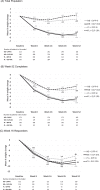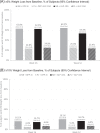Extended-release naltrexone/bupropion is safe and effective among subjects with type 2 diabetes already taking incretin agents: a post-hoc analysis of the LIGHT trial
- PMID: 34083744
- PMCID: PMC8310797
- DOI: 10.1038/s41366-021-00831-4
Extended-release naltrexone/bupropion is safe and effective among subjects with type 2 diabetes already taking incretin agents: a post-hoc analysis of the LIGHT trial
Abstract
Background: Extended-release naltrexone/bupropion (NB) is indicated for chronic weight management. Incretin agents are recommended for patients with type 2 diabetes. This analysis looked at the add-on of NB to incretins to see if weight loss could occur in patients already stabilized on incretin agents.
Methods: This was a post-hoc analysis of NB vs. placebo (PL) among subjects with type 2 diabetes stable on an incretin agent prior to randomization in a double-blind, PL-controlled cardiovascular outcome trial (N = 1317).
Results: Over 1 year, mean weight loss was significantly greater among NB patients vs. PL among those taking DPP-4i (mean absolute difference 4.6% [p < 0.0001]) and those taking GLP-1RAs (mean absolute difference 5.2%, p < 0.0001). Proportions of subjects achieving 5% weight loss were significantly greater for NB vs. PL at weeks 26 and 52 among those taking DPP-4is or GLP-1RAs. There were no significant differences in effectiveness observed between NB + DPP-4i and NB + GLP-1RA or between PL + DPP-4i and PL + GLP-1RA in any of the analyses. Serious adverse events were reported by 9.1% and 11.1% for PL + DPP-4i and PL + GLP-1RA, respectively, and 13.3% and 12.4% of NB + DPP-4i and NB + GLP-1RA, respectively.
Conclusion: NB appears to be effective in reducing weight in patients with T2DM and obesity/overweight who are taking DPP-4ihibitors or GLP-1RA. The SAE rates in all arms of this analysis were lower than have been reported in other cardiovascular outcome trials in type 2 diabetes.
© 2021. The Author(s).
Conflict of interest statement
SW is the owner and director of Wharton Medical Clinic (WMC). He has previously received funding in the form of grants for research from the Canadian Institutes of Health Research and Mitacs. He has also received funding from Novo Nordisk, Bausch Health Canada Inc., Eli Lilly and Company, Janssen Pharmaceuticals, and AstraZeneca for advisory work. EK and RAGC are currently employed by the Wharton Medical Clinic. PY is an employee of Bausch Health Companies. MB (Melonie Burrows) is a former employee of Bausch Health Companies. JB and MB (Maxime Barakat) are employees of, and shareholders in, Bausch Health Companies. FC received consulting fees from Bausch Health, Abbvie Corporation, and Janssen Inc. EG is an employee of Currax Pharmaceuticals LLC.
Figures



Similar articles
-
Real-World Effectiveness of Once-Weekly Glucagon-Like Peptide-1 Receptor Agonists (OW GLP-1RAs) in Comparison with Dipeptidyl Peptidase-4 Inhibitors (DPP-4is) for Glycemic Control and Weight Outcomes in Type 2 Diabetes Mellitus (RELATE).Clin Drug Investig. 2024 Apr;44(4):271-284. doi: 10.1007/s40261-024-01354-2. Epub 2024 Mar 20. Clin Drug Investig. 2024. PMID: 38507188 Free PMC article.
-
A randomized, phase 3 trial of naltrexone SR/bupropion SR on weight and obesity-related risk factors (COR-II).Obesity (Silver Spring). 2013 May;21(5):935-43. doi: 10.1002/oby.20309. Obesity (Silver Spring). 2013. PMID: 23408728 Free PMC article. Clinical Trial.
-
Naltrexone/Bupropion extended release-induced weight loss is independent of nausea in subjects without diabetes.Clin Obes. 2016 Oct;6(5):305-12. doi: 10.1111/cob.12157. Epub 2016 Aug 1. Clin Obes. 2016. PMID: 27477337 Free PMC article. Clinical Trial.
-
Incretin-based therapy in type 2 diabetes: An evidence based systematic review and meta-analysis.J Diabetes Complications. 2018 Jan;32(1):113-122. doi: 10.1016/j.jdiacomp.2016.08.018. Epub 2016 Aug 28. J Diabetes Complications. 2018. PMID: 29074120
-
Comparing once-weekly semaglutide to incretin-based therapies in patients with type 2 diabetes: a systematic review and meta-analysis.Diabetes Metab. 2019 Apr;45(2):102-109. doi: 10.1016/j.diabet.2018.09.002. Epub 2018 Sep 20. Diabetes Metab. 2019. PMID: 30243806
Cited by
-
A web-based scoping review assessing the influence of smoking and smoking cessation on antidiabetic drug meabolism: implications for medication efficacy.Front Pharmacol. 2024 Jun 18;15:1406860. doi: 10.3389/fphar.2024.1406860. eCollection 2024. Front Pharmacol. 2024. PMID: 38957391 Free PMC article.
-
Use of Contrave, Naltrexone with Bupropion, Bupropion, or Naltrexone and Major Adverse Cardiovascular Events: A Systematic Literature Review.Diabetes Metab Syndr Obes. 2022 Sep 29;15:3049-3067. doi: 10.2147/DMSO.S381652. eCollection 2022. Diabetes Metab Syndr Obes. 2022. PMID: 36200062 Free PMC article. Review.
-
Five-year Weight Loss Maintenance With Obesity Pharmacotherapy.J Clin Endocrinol Metab. 2023 Aug 18;108(9):e832-e841. doi: 10.1210/clinem/dgad100. J Clin Endocrinol Metab. 2023. PMID: 36810608 Free PMC article.
-
Long-Term Efficacy and Safety of Nutritional and Pharmacological Strategies for Obesity.Curr Obes Rep. 2025 Jan 3;14(1):1. doi: 10.1007/s13679-024-00602-y. Curr Obes Rep. 2025. PMID: 39753703 Review.
-
Obesity in Adults: Position Statement of Polish Association for the Study on Obesity, Polish Association of Endocrinology, Polish Association of Cardiodiabetology, Polish Psychiatric Association, Section of Metabolic and Bariatric Surgery of the Association of Polish Surgeons, and the College of Family Physicians in Poland.Nutrients. 2023 Mar 28;15(7):1641. doi: 10.3390/nu15071641. Nutrients. 2023. PMID: 37049479 Free PMC article. Review.
References
-
- Wing RR. Weight loss in the management of type 2 diabetes. In: Gerstein HC, Hyanes B, editors. Evidence-based diabetes care. Hamilton. B.C. Decker Inc.; 2000. pp. 252–76.
-
- Diabetes Canada Clinical Practice Guidelines Expert Committee, Wharton S, Pedersen SD, Lau DCW, Sharma AM. Weight management in diabetes. Can J Diabetes. 2018;42(Suppl 1):S124–9. - PubMed
-
- Greenway FL, Fujioka K, Plodkowski RA, Mudaliar S, Guttadauria M, Erickson J, et al. Effect of naltrexone plus bupropion on weight loss in overweight and obese adults (COR-I): a multicentre, randomised, double-blind, placebo-controlled, phase 3 trial. Lancet. 2010;376:595–605. doi: 10.1016/S0140-6736(10)60888-4. - DOI - PubMed
Publication types
MeSH terms
Substances
LinkOut - more resources
Full Text Sources
Other Literature Sources
Medical

